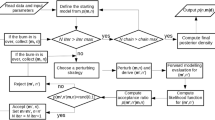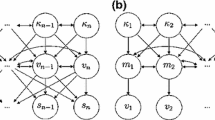Abstract
Seismic inverse modeling, which transforms appropriately processed geophysical data into the physical properties of the Earth, is an essential process for reservoir characterization. This paper proposes a work flow based on a Markov chain Monte Carlo method consistent with geology, well-logs, seismic data, and rock-physics information. It uses direct sampling as a multiple-point geostatistical method for generating realizations from the prior distribution, and Metropolis sampling with adaptive spatial resampling to perform an approximate sampling from the posterior distribution, conditioned to the geophysical data. Because it can assess important uncertainties, sampling is a more general approach than just finding the most likely model. However, since rejection sampling requires a large number of evaluations for generating the posterior distribution, it is inefficient and not suitable for reservoir modeling. Metropolis sampling is able to perform an equivalent sampling by forming a Markov chain. The iterative spatial resampling algorithm perturbs realizations of a spatially dependent variable, while preserving its spatial structure by conditioning to subset points. However, in most practical applications, when the subset conditioning points are selected at random, it can get stuck for a very long time in a non-optimal local minimum. In this paper it is demonstrated that adaptive subset sampling improves the efficiency of iterative spatial resampling. Depending on the acceptance/rejection criteria, it is possible to obtain a chain of geostatistical realizations aimed at characterizing the posterior distribution with Metropolis sampling. The validity and applicability of the proposed method are illustrated by results for seismic lithofacies inversion on the Stanford VI synthetic test sets.















Similar content being viewed by others
References
Andrieu C, Thoms J (2008) A tutorial on adaptive MCMC. Stat Comput 18:343–373
Andrieu C, Freitas ND, Doucet A, Jordan MI (2003) An introduction to MCMC for machine learning. Mach Learn 50:5–43
Arpat BG (2005) Sequential simulation with patterns. Dissertation, Stanford University
Avseth P, Mukerji T, Mavko G (2005) Quantitative seismic interpretation. Cambridge University Press, Cambridge
Azevedo L, Nunes RF, Almeida JA, Pinheiro LM, Caeiro MH, Correia PJ, Soares A (2012) Seismic attributes for constraining geostatistical seismic inversion. In: 9th International geostatistics congress, June 11–15, 2012, Oslo, Norway
Bachrach R (2006) Joint estimation of porosity and saturation using stochastic rock-physics modeling. Geophysics 71(5):O53–O63. doi:10.1190/1.2235991
Bleistein N, Gray SH (1985) An extension of the Born inversion procedure to depth dependent velocity profiles. Geophys Prosp 33(7):999–1022
Bosch M, Cara L, Rodrigues J, Navarro A, Diaz M (2004) The optimization approach to lithological tomography: combining seismic data and petrophysics for porosity prediction. Geophysics 69:1272–1282
Bosch M (1999) Lithologic tomography: from plural geophysical data to lithology estimation. J Geophys Res 104:749–766
Bosch M, Mukerji T, Gonzalez EF (2010) Seismic inversion for reservoir properties combining statistical rock physics and geostatistics: a review. Geophysics 75(5):165–176
Castro S, Caers J, Mukerji T (2005) The Stanford VI reservoir. 18th annual report, Stanford Center for Reservoir Forecasting, Stanford University
Contreras A, Torres-Verdin C, Chesters W, Kvien K, Fasnacht T (2005) Joint stochastic inversion of 3D pre-stack seismic data and well logs for high-resolution reservoir characterization and petrophysical modeling: application to deepwater hydrocarbon reservoirs in the central Gulf of Mexico. In: 75th annual international meeting, SEG expanded abstracts, pp 1343–1346
Doyen PM (2007) Seismic reservoir characterization: an earth modeling perspective. EAGE Publications, Houten
Dubrule O (2003) Geostatistics for seismic data integration in earth models. SEG Publications, Tulsa
Eidsvik J, Avseth P, Omre H, Mukerji T, Mavko G (2004) Stochastic reservoir characterization using prestack seismic data. Geophysics 69:978–993. doi:10.1190/1.1778241
Gonzalez EF, Mukerji T, Mavko G (2008) Seismic inversion combining rock physics and multiple-point geostatistics. Geophysics 73(1):R11–R21
Griffin JE, Walker SG (2013) On adaptive Metropolis–Hasting methods. Stat Comput 23:123–134. doi:10.1007/s11222-011-9296-2
Haario H, Saksman E, Tamminen J (2001) An adaptive Metropolis algorithm. Bernoulli 7:223–242
Hansen TM, Mosegaard K, Cordua KC (2008) Using geostatistics to describe complex a priori information for inverse problems. In: Proceedings from VIII international geostatistics congress, vol 1, pp 329–338
Hansen TM, Cordua KC, Mosegaard K (2012) Inverse problems with non-trivial priors—efficient solution through sequential gibbs sampling. Comput Geosci 16(3):593–611
Honarkah M, Caers J (2012) Direct pattern-based simulation of non-stationary geostatistical models. Math Geosci 44(6):651–672
Jeong C (2014) Quantitative reservoir characterization integrating seismic data and geological scenario uncertainty. Dissertation, Stanford University
Larsen AL, Ulvmoen M, Omre H, Buland A (2006) Bayesian lithology/fluid prediction and simulation on the basis of a Markov-chain prior model. Geophysics 71(5):R69–R78. doi:10.1190/1.2245469
Mariethoz G, Renard P, Straubhaar J (2010a) The direct sampling method to perform multiple-points geostatistical simulations. Water Resour Res 46:W11536
Mariethoz G, Renard P, Caers J (2010b) Bayesian inverse problem and optimization with iterative spatial resampling. Water Resour Res 46:W11530
Metropolis N, Rosenbluth AW, Rosenbluth MN, Teller AH, Teller E (1953) Equation of state calculations by fast computing machines. J Chem Phys 21:1087–1092
Mosegaard K, Tarantola A (1995) Monte Carlo sampling of solutions to inverse problems. J Geophys Res 100(B7):12431–12447
Mukerji T, Avseth P, Mavko G, Takahashi I, Gonzalez EF (2001a) Statistical rock physics: combining rock physics, information theory, and geostatistics to reduce uncertainty in seismic reservoir characterization. Lead Edge 20(3):313–319
Mukerji T, Jorstad A, Avseth P, Mavko G, Granli JR (2001b) Mapping lithofacies and pore-fluid probabilities in a North Sea reservoir: seismic inversions and statistical rock physics. Geophysics 66:988–1001
Mukerji T, Mavko G, Rio P (1997) Scales of reservoir heterogeneities and impact of seismic resolution on geostatistical integration. Math Geol 29(7):933–950
Roberts GO, Rosenthal JS (2009) Examples of adaptive MCMC. J Comput Graph Stat 18:349–367
Scheidt C, Caers J (2009) Representing spatial uncertainty using distances and kernels. Math Geosci 41(4):397–419
Scheidt C, Jeong C, Mukerji T, Caers J (2015) Probabilistic falsification of prior geologic uncertainty with seismic amplitude data: application to a turbidite reservoir case. Geophysics 80(5):M89–M12. doi:10.1190/geo2015-0084.1
Strebelle SB, Journel AG (2001) Reservoir modeling using multiple point statistics. In: SPE 71324 presented at the 2001 SPE annual technical conference and exhibition, New Orleans, 30 September–3 October 2001
Tahmasebi P, Hezarkhani A, Sahimi M (2012) Multiple-point geostatistical modeling based on the cross-correlation functions. Comput Geosci 16:779–797. doi:10.1007/s10596-012-9287-1
Tarantola A (1987) Inverse problem theory: methods for data fitting and model parameter estimation. Elsevier, Amsterdam
Tarantola A (2005) Inverse problem theory and methods for model parameter estimation. SIAM, Philadelphia
Ulvmoen M, Omre H (2010) Improved resolution in Bayesian lithology/fluid inversion from prestack seismic data and well observations: part 1—methodology. Geophysics 75(2):R21–R35
von Seggern DH (1991) Spatial resolution of acoustic imaging with the Born approximation. Geophysics 56(8):1185–1202
Acknowledgements
This research was funded by Stanford Center for Reservoir Forecasting (SCRF) sponsors.
Author information
Authors and Affiliations
Corresponding author
Rights and permissions
About this article
Cite this article
Jeong, C., Mukerji, T. & Mariethoz, G. A Fast Approximation for Seismic Inverse Modeling: Adaptive Spatial Resampling. Math Geosci 49, 845–869 (2017). https://doi.org/10.1007/s11004-017-9693-y
Received:
Accepted:
Published:
Issue Date:
DOI: https://doi.org/10.1007/s11004-017-9693-y




